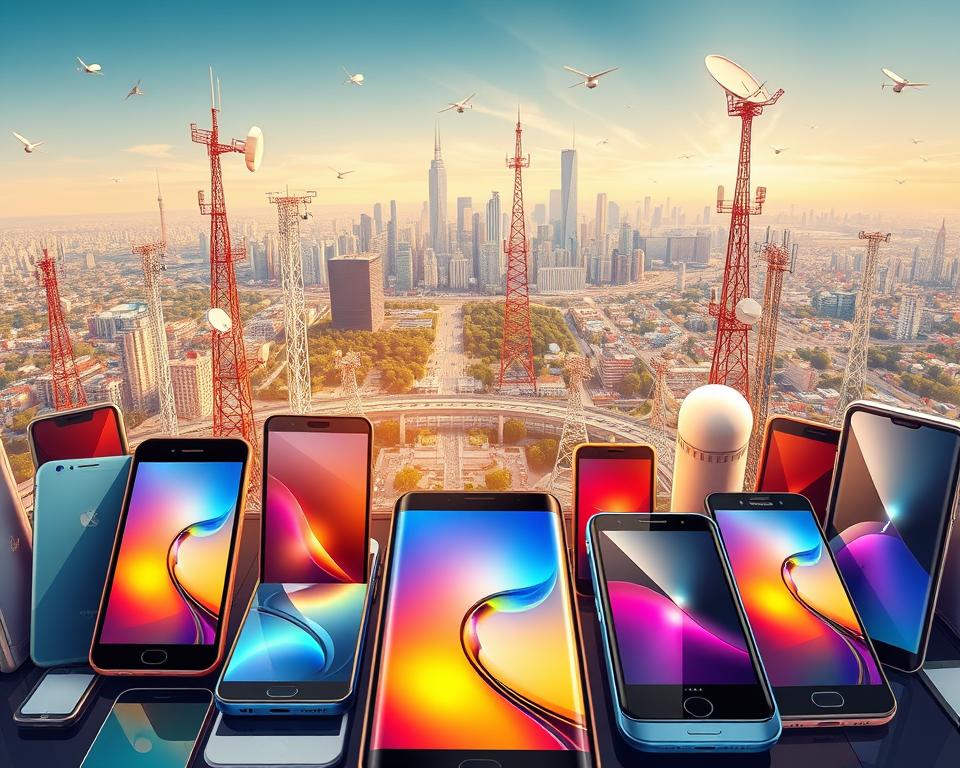
Mobile Technology Explained: Download the Definitive PDF
Did you know that over 5 billion people worldwide use mobile devices? This staggering number highlights the significance of mobile technology in our daily lives. As we increasingly rely on our devices for communication, entertainment, and information, understanding the concepts behind mobile technology has become essential.

A comprehensive understanding of mobile technology can help you navigate the digital landscape more effectively. Our definitive PDF download provides an in-depth look at the various aspects and applications of mobile technology, serving as a valuable resource for those looking to expand their knowledge.
Key Takeaways
- Understanding mobile technology is crucial in today’s digital age.
- The definitive PDF download offers a comprehensive overview.
- Mobile technology has numerous applications across various industries.
- Staying informed about mobile technology can enhance your digital experience.
- Our PDF download is a valuable resource for both beginners and experts.
The Fundamentals of Mobile Technology
As mobile devices become increasingly ubiquitous, grasping the fundamentals of mobile technology is more important than ever. Mobile technology encompasses a broad range of technologies, protocols, and systems that enable mobile communication and computing.
Definition and Core Concepts
At its core, mobile technology refers to the technology used for cellular communication. It involves mobile devices such as smartphones, tablets, and wearables, along with the infrastructure that supports them.
Key Terminology and Components
Understanding mobile technology requires familiarity with key terms like cellular networks, mobile operating systems, and mobile applications. These components work together to provide users with a seamless experience.
Mobile Technology Ecosystem
The mobile technology ecosystem is complex, involving hardware manufacturers, software developers, and telecommunications providers. This ecosystem is constantly evolving, driven by consumer demand for more innovative and capable devices.

Historical Evolution of Mobile Technology
Mobile technology has come a long way since the first generation of mobile phones. The transition from 1G to 5G has marked significant improvements in data speeds and connectivity.
Major Milestones and Breakthroughs
Key milestones include the introduction of smartphones, which integrated computing capabilities into mobile devices, and the development of mobile internet, enabling users to access the web on the go.
Technological Convergence
The convergence of various technologies has played a crucial role in the evolution of mobile technology. This includes advancements in processor technology, display technology, and artificial intelligence, which have collectively enhanced the mobile experience.
What is Mobile Technology PDF: Your Complete Resource Guide
Our definitive Mobile Technology PDF serves as a complete resource for anyone looking to grasp the fundamentals and beyond of mobile technology. This comprehensive guide is designed to cater to the needs of individuals seeking a thorough understanding of the subject.
Contents of Our Definitive Mobile Technology PDF
The PDF is structured into several chapters, each focusing on key aspects of mobile technology.
Chapter Breakdown and Key Topics
The guide covers a wide range of topics, from the historical evolution of mobile technology to the latest advancements in mobile networks and connectivity.
- Introduction to Mobile Technology
- Evolution of Mobile Devices
- Mobile Operating Systems
- Mobile Networks and Connectivity
Visual Aids and Diagrams
To enhance understanding, the PDF includes various visual aids such as diagrams and infographics. For instance,

How to Use This Resource Effectively
To maximize the benefits of our Mobile Technology PDF, readers can utilize the navigation tips and bookmarks provided.
Navigation Tips and Bookmarks
Using the bookmarks, readers can quickly jump to sections of interest, making it easier to navigate through the guide.
Practical Application of Information
The information provided in the PDF can be applied in various practical ways, such as understanding mobile technology trends and applying this knowledge in real-world scenarios.
| Chapter | Key Topics |
|---|---|
| 1 | Introduction to Mobile Technology |
| 2 | Evolution of Mobile Devices |
| 3 | Mobile Operating Systems |
The Evolution of Mobile Devices
From bulky brick phones to sleek smartphones, the evolution of mobile devices has been remarkable. Over the years, mobile technology has advanced significantly, transforming the way we communicate, work, and entertain ourselves.
From Brick Phones to Smartphones
The journey began with the first mobile phones, which were large and cumbersome. However, with advancements in technology, these devices became smaller, more powerful, and feature-rich.
Key Technological Leaps
Several key technological advancements have driven the evolution of mobile devices. These include improvements in processor speed, memory capacity, and display technology.
Form Factor Evolution
The design of mobile devices has also undergone significant changes. From the early brick phones to flip phones, and now to smartphones with touchscreens, the form factor has evolved to make devices more user-friendly and aesthetically pleasing.

Tablets, Wearables, and Beyond
In addition to smartphones, other categories of mobile devices have emerged, including tablets, smartwatches, and fitness trackers.
Smartwatches and Fitness Trackers
These wearable devices have gained popularity for their ability to track health and fitness metrics, receive notifications, and control music playback.
| Device Category | Key Features |
|---|---|
| Smartphones | Touchscreen, internet connectivity, apps |
| Tablets | Larger screens, productivity, entertainment |
| Smartwatches | Health tracking, notifications, music control |
Mobile Operating Systems Explained
As mobile devices become increasingly integral to our daily lives, understanding their operating systems is essential. Mobile operating systems are the software platforms that power our smartphones and tablets, enabling us to interact with our devices and access various applications.
iOS vs Android: Key Differences
The two dominant players in the mobile operating system market are iOS and Android. While both offer a range of features and functionalities, there are significant differences between them.
User Interface and Experience
iOS is known for its sleek, intuitive interface and seamless user experience. Android, on the other hand, offers more customization options and flexibility. As Tim Cook, Apple’s CEO, once said,
“We think there’s a profound difference between an app that just does something and an app that is beautifully designed.”
App Ecosystems and Development
Both iOS and Android have vast app ecosystems, with millions of applications available for download. However, the development processes and guidelines differ significantly between the two platforms.
Other Mobile Operating Systems
While iOS and Android dominate the market, other mobile operating systems like HarmonyOS and KaiOS are gaining traction.
HarmonyOS, KaiOS, and Alternatives
HarmonyOS, developed by Huawei, is designed to be a cross-platform operating system, allowing for seamless integration across different devices. KaiOS, on the other hand, is a lightweight operating system designed for feature phones and entry-level smartphones.
Operating System Security Comparison
Security is a critical aspect of mobile operating systems. iOS and Android have robust security features, but they differ in their approaches. A comparison of their security features reveals that both have their strengths and weaknesses.

In conclusion, understanding the different mobile operating systems is crucial for making informed decisions about our mobile devices. By comparing their features, functionalities, and security measures, we can better appreciate the complexities of mobile technology.
Mobile Networks and Connectivity
The backbone of mobile technology lies in its networks and connectivity, enabling seamless communication and data transfer. As mobile devices become increasingly integral to daily life, understanding the complexities of mobile networks is crucial.
Cellular Networks: From 1G to 5G
Cellular networks have evolved significantly, from the first generation (1G) to the current fifth generation (5G). Each iteration has brought about substantial improvements in speed, capacity, and accessibility.
Speed and Capacity Evolution
The transition from 1G to 5G has seen data transfer rates increase from kilobits per second to gigabits per second. This evolution has enabled the widespread adoption of data-intensive applications.
Coverage and Accessibility
Advancements in cellular networks have also expanded coverage and improved accessibility, especially in rural and underserved areas.
Wi-Fi, Bluetooth, and Other Connection Technologies
Beyond cellular networks, technologies like Wi-Fi, Bluetooth, and Near Field Communication (NFC) play vital roles in mobile connectivity.
Near Field Communication (NFC)
NFC enables close-range data transfer, commonly used in contactless payments and data exchange between devices.
Satellite Connectivity
Satellite connectivity provides an alternative for areas where traditional networks are unavailable, ensuring global coverage.
Future of Mobile Connectivity
The future of mobile connectivity is poised for further innovation, with research into 6G and global internet access initiatives underway.
6G Research and Development
Early research into 6G promises even faster data rates and lower latency, potentially revolutionizing mobile technology further.
Global Internet Access Initiatives
Initiatives aimed at providing global internet access seek to bridge the digital divide, ensuring everyone can benefit from mobile technology.
| Technology | Key Features | Applications |
|---|---|---|
| 5G | High speed, low latency | Enhanced mobile broadband, IoT |
| Wi-Fi | Local area networking | Internet access, device-to-device transfer |
| NFC | Close-range data transfer | Contactless payments, data exchange |
Mobile Hardware Components
Understanding mobile technology requires a deep dive into the hardware that powers our devices. The hardware components of mobile devices are intricate and multifaceted, playing a crucial role in their overall functionality and user experience.
Processors and Memory
The brain of any mobile device is its processor, or CPU, which handles all the instructions and tasks. Mobile CPU architecture has evolved to become more powerful and efficient, enabling smoother performance and multitasking.
Mobile CPU Architecture
Modern mobile CPUs are designed with multiple cores, enhancing their ability to handle demanding tasks. This architecture is crucial for understanding mobile technology and its applications in daily life.
RAM and Storage Technologies
RAM (Random Access Memory) and storage are vital components that affect a device’s performance. Adequate RAM ensures that multiple apps can run simultaneously without lag, while storage technologies like eMMC, UFS, and the emerging trend of using SSD-like storage in mobile devices, impact data access speeds.
Displays and Touchscreen Technology
The display is one of the most interactive components of a mobile device, with various technologies available, including LCD, OLED, and MicroLED. Each has its advantages, from brightness and color accuracy to power efficiency.
LCD vs OLED vs MicroLED
LCDs are known for their brightness, while OLEDs offer superior contrast and color accuracy. MicroLED technology is emerging as a potential game-changer, offering the best of both worlds. Understanding these technologies is key to mobile technology applications in various fields.
Foldable and Flexible Displays
The advent of foldable and flexible displays has opened new possibilities for mobile device design. These displays are not only aesthetically pleasing but also offer new ways to interact with devices, further enhancing mobile technology applications.
Cameras and Sensors
Cameras and sensors have become increasingly sophisticated, enabling features like computational photography and biometric authentication. These advancements have significantly enhanced the user experience and security of mobile devices.
Computational Photography
Computational photography involves using software to enhance and extend the capabilities of camera hardware. Techniques like multi-shot noise reduction, portrait mode, and night mode have become standard, making mobile cameras highly capable.
Biometric Authentication Systems
Biometric sensors, including fingerprint readers, facial recognition systems, and iris scanners, provide secure authentication methods. These technologies have become integral to the security features of modern mobile devices, illustrating the importance of understanding mobile technology.
Mobile software and applications have revolutionized the way we interact with our devices, offering a plethora of services at our fingertips.
Mobile app ecosystems are complex environments that include app stores, distribution channels, and monetization models. These ecosystems are crucial for the development and dissemination of mobile applications.
App Stores and Distribution
App stores like Apple App Store and Google Play Store are primary distribution channels for mobile apps. They provide a platform for developers to publish their apps and for users to discover and download them.
Monetization Models
Developers use various monetization models, including in-app purchases, subscriptions, and advertising. The choice of model depends on the app’s functionality and target audience.
Types of Mobile Applications
Mobile applications can be categorized into native, web, and hybrid apps, each with its own advantages and development requirements.
Native vs Web vs Hybrid Apps
Native apps are built for specific platforms and offer high performance. Web apps are accessed through browsers and are platform-independent. Hybrid apps combine elements of both native and web apps.
Progressive Web Applications
Progressive Web Applications (PWAs) offer a native app-like experience through web technologies. They are gaining popularity due to their ease of development and deployment.
App Development Basics
App development involves several key steps, including choosing the right development framework and designing a user-friendly interface.
Popular Development Frameworks
Frameworks like React Native and Flutter allow developers to build cross-platform apps efficiently.
User Experience Design Principles
A well-designed user interface is crucial for an app’s success. It should be intuitive, responsive, and visually appealing.
Understanding mobile software and applications is essential for leveraging the full potential of mobile technology. By exploring the different types of apps and development strategies, users and developers can enhance their mobile experience.
Advantages of Mobile Technology in Daily Life
Mobile technology has seamlessly integrated into our daily lives, offering numerous benefits. The advantages of mobile technology are evident in various aspects of our daily routines, from communication and information access to productivity and entertainment.
Communication and Social Connectivity
One of the significant mobile technology benefits is enhanced communication and social connectivity. Mobile devices enable us to stay connected with family, friends, and colleagues through various means.
Messaging and Video Calling
With mobile technology, messaging apps and video calling features have made it easier to stay in touch with loved ones, regardless of geographical distances. Video calling, in particular, has added a personal touch to long-distance communication.
Social Media Integration
Mobile devices allow for seamless integration with social media platforms, enabling users to share updates, photos, and videos with their networks. This has transformed the way we share our experiences and connect with others.
Information Access and Productivity
Mobile technology has also revolutionized the way we access information and manage our productivity. With the internet at our fingertips, we can quickly look up information, check emails, and manage our schedules.
Mobile Productivity Suites
Mobile productivity suites offer a range of tools and applications that enable users to work on documents, spreadsheets, and presentations on the go. This has significantly enhanced our ability to work remotely and stay productive.
Cloud integration and synchronization capabilities ensure that our data is accessible across all our devices, providing a seamless and efficient workflow.
Entertainment and Media Consumption
Mobile technology has also transformed the way we consume entertainment and media. With streaming services and mobile gaming, we have a wide range of options for leisure activities.
Streaming Services and Mobile Gaming
Streaming services have made it possible to access a vast library of movies, TV shows, and music on the go. Mobile gaming has also become increasingly popular, offering a range of engaging and interactive experiences.
Content Creation Tools
Furthermore, mobile technology has enabled content creation through various apps and tools, allowing users to capture, edit, and share content easily.
In conclusion, the advantages of mobile technology in daily life are multifaceted, enhancing our communication, productivity, and entertainment options. As mobile technology continues to evolve, we can expect even more innovative solutions to emerge, further enriching our daily experiences.
Mobile Technology in Business and Enterprise
In today’s fast-paced business environment, mobile technology plays a crucial role in driving innovation and efficiency. Companies are leveraging mobile solutions to enhance customer engagement, streamline operations, and stay competitive in a rapidly evolving market.
Mobile Commerce and Payment Systems
Mobile commerce has emerged as a significant trend, with businesses adopting mobile-friendly platforms to cater to the growing number of mobile users. This shift has also led to the development of advanced payment systems.
Digital Wallets and Contactless Payments
Digital wallets and contactless payments have gained popularity, offering consumers a convenient and secure way to make transactions. Services like Apple Pay and Google Wallet have become increasingly popular, enabling users to make payments with their smartphones.
Mobile Banking Revolution
The mobile banking revolution has transformed the financial services landscape, allowing customers to manage their accounts, transfer funds, and pay bills on the go. Mobile banking apps have become essential tools for financial management.
Enterprise Mobility Management
As mobile devices become more integral to business operations, enterprise mobility management has become a critical concern. Companies are implementing policies and solutions to manage mobile devices and ensure security.
BYOD Policies and Security
BYOD (Bring Your Own Device) policies have become common, allowing employees to use their personal devices for work. However, this trend also raises security concerns, necessitating robust security measures.
Mobile Device Management Solutions
Mobile Device Management (MDM) solutions help businesses manage and secure their mobile devices, ensuring that company data remains protected.
Mobile-First Business Strategies
Many businesses are adopting mobile-first strategies, prioritizing mobile platforms to reach customers and drive engagement. This approach involves optimizing websites and applications for mobile devices.
Customer Engagement through Mobile
Mobile technology enables businesses to engage with customers in new and innovative ways, such as through mobile apps and SMS marketing campaigns.
Mobile analytics provides valuable insights into customer behavior, helping businesses make informed decisions and improve their mobile strategies.
As
“The future of business is mobile.”
, it’s clear that companies must continue to adapt and innovate in the mobile space to remain competitive.
Mobile Technology in Education
The impact of mobile technology on education has been profound, changing the landscape of learning. With the rise of mobile devices, educational resources are now more accessible than ever, enabling students to learn anywhere, anytime.
Mobile Learning Platforms
Mobile learning platforms have emerged as a key component of modern education. These platforms offer a range of features, including:
- Interactive Educational Content: Engaging content that makes learning more enjoyable and effective.
- Distance Learning Solutions: Enabling students to access educational resources remotely, breaking geographical barriers.
Educational Apps and Resources
Educational apps and resources are being developed to cater to diverse learning needs. Some notable examples include:
- Subject-Specific Learning Tools: Apps designed to help students master specific subjects, such as mathematics or language arts.
- Gamification in Education: Using game design elements to make learning more engaging and fun.
Challenges and Opportunities
While mobile technology presents numerous opportunities for education, it also poses challenges. Some of these include:
- Digital Literacy Development: The need to equip students with the skills to effectively use digital technologies.
- Bridging Educational Gaps: Using mobile technology to address disparities in access to education.
By understanding mobile technology resources and leveraging them effectively, educators can create more inclusive and engaging learning environments.
Mobile Technology in Healthcare
The integration of mobile technology in healthcare has revolutionized patient care and medical practices. Mobile devices and applications are being used to improve patient outcomes, enhance medical training, and streamline healthcare services.
Telemedicine and Remote Patient Monitoring
Telemedicine has emerged as a significant application of mobile technology in healthcare, enabling remote consultations and patient monitoring. This has been particularly beneficial for patients with chronic conditions or those living in remote areas.
Virtual Consultations
Virtual consultations allow patients to connect with healthcare providers remotely, reducing the need for in-person visits. This has improved access to healthcare services, especially during the COVID-19 pandemic.
Wearable Health Monitors
Wearable health monitors track vital signs and other health metrics, enabling continuous monitoring of patients. This data can be shared with healthcare providers in real-time, facilitating timely interventions.
Health and Fitness Applications
Health and fitness applications are being used to promote wellness and manage chronic diseases. These apps offer features such as wellness tracking, fitness coaching, and disease management.
Wellness Tracking and Management
Wellness tracking apps help users monitor their physical activity, sleep patterns, and nutrition. This information can be used to make informed lifestyle changes.
Chronic Disease Management
Chronic disease management apps provide tools and resources for managing conditions such as diabetes, hypertension, and asthma. These apps can help patients adhere to treatment plans and monitor their condition.
Medical Training and Reference Tools
Mobile technology is also being used to enhance medical education and training.
Anatomical Models and Simulations
Anatomical models and simulations provide interactive learning experiences for medical students and professionals. These tools can enhance understanding of complex anatomical structures and procedures.
Point-of-Care Reference Apps
Point-of-care reference apps offer healthcare professionals access to medical information, guidelines, and treatment protocols at the bedside. This can improve decision-making and patient care.
| Application | Description | Benefits |
|---|---|---|
| Telemedicine | Remote consultations and patient monitoring | Improved access to healthcare, reduced costs |
| Wearable Health Monitors | Continuous tracking of vital signs and health metrics | Timely interventions, improved patient outcomes |
| Health and Fitness Apps | Wellness tracking, fitness coaching, disease management | Promotes wellness, improves disease management |
Mobile Technology Impact on Society
As mobile technology continues to evolve, its impact on societal norms and behaviors becomes increasingly evident. The influence of mobile devices is far-reaching, affecting various aspects of our daily lives, from how we communicate to how we access information and services.
Social and Cultural Changes
Mobile technology has significantly altered communication patterns. With the rise of smartphones, people can now stay connected with others across geographical distances. This shift has led to changes in social dynamics, with both positive and negative consequences.
Communication Patterns
The way we communicate has become more instant and visual, with the prevalence of messaging apps and social media platforms. This has opened up new avenues for social interaction but also raises concerns about the quality of these interactions.
Digital Nomad Lifestyle
The flexibility offered by mobile technology has enabled the rise of the digital nomad lifestyle. Professionals can now work remotely, traveling and experiencing different cultures while maintaining their careers.
Digital Divide and Accessibility Issues
Despite the many benefits, mobile technology also exacerbates existing inequalities. The digital divide refers to the gap between those who have access to modern information and communication technology and those who do not.
Geographic and Economic Disparities
In many regions, access to reliable internet and modern mobile devices is limited by economic and geographic factors. This disparity can hinder social and economic development.
Inclusive Design Approaches
To address these issues, there is a growing emphasis on inclusive design approaches that make mobile technology more accessible to diverse populations, including those with disabilities.
Privacy and Ethical Considerations
As mobile technology becomes more pervasive, concerns about privacy and ethical use grow. The collection and use of personal data by mobile apps and services are key areas of concern.
Data Collection Practices
Many mobile apps collect user data, often for targeted advertising. Understanding these practices and their implications is crucial for users.
Screen Time and Digital Wellbeing
Excessive screen time can have negative effects on mental and physical health. Promoting digital wellbeing involves finding a balance between the benefits of mobile technology and the need to disconnect.
| Aspect | Positive Impact | Negative Impact |
|---|---|---|
| Communication | Increased connectivity | Decreased face-to-face interaction |
| Accessibility | Improved access to information | Exacerbated digital divide |
| Privacy | Enhanced security features | Concerns over data collection |
Current Mobile Technology Trends
The mobile technology landscape is rapidly evolving with advancements in artificial intelligence and augmented reality. As we explore these trends, it’s essential to understand their impact on various aspects of our lives.
Artificial Intelligence and Machine Learning
Artificial Intelligence (AI) and Machine Learning (ML) are transforming mobile technology by enabling more personalized and efficient user experiences. On-device AI processing is becoming increasingly popular, allowing for faster and more secure data processing directly on the device.
On-device AI processing reduces reliance on cloud computing, enhancing privacy and reducing latency. This technology is crucial for applications that require real-time processing, such as voice assistants and image recognition.
Voice Assistants and Natural Language Processing
Voice assistants like Siri, Google Assistant, and Alexa are becoming more sophisticated with advancements in Natural Language Processing (NLP). NLP enables these assistants to understand and respond to user queries more accurately.
Augmented and Virtual Reality
Augmented Reality (AR) and Virtual Reality (VR) are changing the way we interact with information and entertainment on our mobile devices. are enhancing the shopping experience by allowing customers to visualize products in their environment.
AR Applications in Retail and Navigation
AR is being used in retail to provide customers with a more immersive shopping experience. Additionally, AR is used in navigation apps to provide users with more intuitive directions.
VR Entertainment and Training
VR is primarily used for entertainment, offering immersive gaming experiences. It’s also used for training purposes, providing a safe and controlled environment for users to practice skills.
Internet of Things (IoT) Integration
The Internet of Things (IoT) is being integrated into mobile technology, enabling greater control over smart devices. Smart home control is one of the most significant applications of IoT in mobile technology.
Smart Home Control
Mobile devices can now control various smart home devices, such as thermostats, lighting, and security cameras, making it easier to manage home environments remotely.
Connected Vehicles and Transportation
IoT is also being used in connected vehicles, enhancing safety and navigation. This technology has the potential to revolutionize the transportation industry.
As mobile technology continues to evolve, we can expect to see even more innovative applications of AI, AR, VR, and IoT. These technologies are set to transform various aspects of our lives, from how we interact with information to how we navigate our surroundings.
Mobile Security and Privacy
Ensuring mobile security and privacy is vital in protecting sensitive information in our increasingly mobile world. As we continue to rely on our mobile devices for various aspects of our lives, from communication and banking to shopping and entertainment, the risk of security breaches and privacy violations grows.
Common Mobile Security Threats
Mobile devices face numerous security threats, including malware and phishing attacks, which can compromise personal data and disrupt service.
Malware and Phishing Attacks
Malware can infiltrate a device through seemingly harmless apps or links, while phishing attacks trick users into revealing sensitive information. To protect against these threats, it’s essential to be cautious when downloading apps and clicking on links.
Public Wi-Fi Risks
Using public Wi-Fi networks can expose your device to man-in-the-middle attacks, where hackers intercept your data. It’s advisable to use a VPN (Virtual Private Network) when connecting to public Wi-Fi to encrypt your internet traffic.
Best Practices for Mobile Security
Implementing robust security measures can significantly reduce the risk of mobile security breaches.
Authentication Methods
Using strong authentication methods, such as biometric authentication (fingerprint or facial recognition) and complex passwords, can prevent unauthorized access to your device.
App Permission Management
Carefully managing app permissions is crucial. Only grant necessary permissions to apps to minimize the risk of data exposure.
Privacy Tools and Settings
Utilizing privacy tools and adjusting settings on your device can enhance your privacy.
VPNs and Encrypted Communications
Employing a VPN encrypts your internet traffic, protecting your data from interception. Additionally, using end-to-end encrypted messaging apps ensures that your communications remain private.
Ad Blocking and Tracking Prevention
Using ad blockers and enabling tracking prevention features in your browser or through dedicated apps can reduce targeted advertising and enhance your privacy online.
How to Download and Use Our Mobile Technology PDF
Get instant access to our detailed Mobile Technology PDF by following the steps outlined in this section. Our comprehensive guide is designed to provide you with a thorough understanding of mobile technology, covering various aspects from the basics to advanced topics.
Download Instructions
To download our Mobile Technology PDF, follow these simple steps:
- Click on the download link provided on our website.
- Select the location on your device where you want to save the PDF.
- Wait for the download to complete.
System Requirements
Ensure your device meets the following system requirements to open and view the PDF:
- Operating System: Windows, macOS, or Linux.
- PDF Reader Software: Adobe Acrobat Reader or compatible software.
File Format and Size
Our Mobile Technology PDF is available in PDF format, ensuring compatibility with most devices. The file size is approximately X MB, making it easily downloadable even on slower internet connections.
Navigating the PDF Content
The PDF is structured to be user-friendly, with clear headings and interactive elements. Here’s how to make the most of it:
Interactive Elements and Features
The PDF includes hyperlinks to external resources, clickable table of contents, and cross-references for easy navigation.
Search Functionality
Use the search function in your PDF reader to quickly find specific topics or keywords within the document. This feature is particularly useful for locating information on advanced topics or specific technologies.
“The ability to search within the PDF enhances the user experience, making it a valuable resource for both quick references and in-depth study.” – Expert Review
Additional Resources and Updates
To complement our Mobile Technology PDF, we offer additional resources and updates to keep your knowledge current.
Companion Materials
Check our website for companion materials, including webinars, videos, and supplementary guides that expand on the topics covered in the PDF.
Future Edition Notifications
Sign up for our newsletter to receive notifications about future editions of the Mobile Technology PDF, ensuring you stay up-to-date with the latest developments in mobile technology.
Conclusion: Embracing the Mobile Technology Revolution
As we’ve explored throughout this definitive guide, mobile technology has revolutionized the way we live, work, and interact with one another. From its humble beginnings to the current state of advanced smartphones and mobile devices, mobile technology has come a long way, transforming our daily lives and shaping the future of various industries.
A comprehensive mobile technology overview reveals the vast impact of mobile devices on society, from enhancing communication and social connectivity to driving business growth and improving healthcare outcomes. The mobile technology impact on society is multifaceted, influencing cultural norms, economic development, and access to information.
As we move forward, embracing the mobile technology revolution is crucial for individuals, businesses, and societies to stay ahead of the curve. By understanding the fundamentals of mobile technology, its applications, and its implications, we can harness its potential to create a more connected, efficient, and innovative world.



